Amtrak Rolls Out New Locomotives
And new branding. And connecting trains in Chicago have increased their speed.
Imagine gliding on the rails between Milwaukee and Chicago in the sleekest, shiniest and most up-to-date rolling stock in the nation, U.S.-made and fully “Buy America” compliant. As of earlier this year, with the new Amtrak Midwest Charger locomotives now in service, one lucky person — the engineer — now has that luxury.
The passengers and the train’s two conductors will have to wait, since the engines will haul them in the same old Horizon Fleet cars that date to the 1980s.
The locomotives were intended to haul new Talgo cars, built in Wisconsin. The Talgo cars were rejected by Gov. Scott Walker and the sad impact of that decision can be found in our past stories here and here.
Traffic Up on Line, Yet Speeds Steady Here
The Midwest Hiawatha had 829,000 passengers in the federal fiscal year that ended in September, a 2.6 percent increase, according to Arun Rao of the Wisconsin Department of Transportation, one of the agencies representing the four states that operate passenger service under contract with the national railroad company.
Illinois was the lead member of the consortium including Wisconsin, Missouri and Michigan that contracted in 2014 for the manufacture of 33 diesel electric Siemens Charger locomotives at a cost of $225 million.
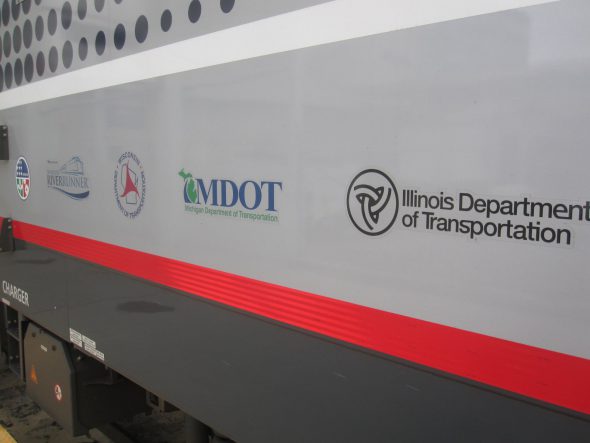
The logos of each of the state agencies in the consortium accompanies those of Amtrak and of the American Recovery Act on the sides of the locomotives. Photo by Michael Horne.
The logos of each of the state agencies accompanies those of Amtrak and of the American Recovery Act on the sides of the locomotives. The American Recovery and Reinvestment Act of 2009 was to have provided the $810 million for the passenger cars to accompany the Wisconsin trains that Walker rejected. (Wisconsin taxpayers would up paying $50 million for trains that would have been free, and we didn’t even get the trains.)
Rao of the DOT noted that the locomotive also bore the “Amtrak Midwest” brand to emphasize that this is a “regional network of routes supported by states.” The idea is that people recognize that Chicago, the nation’s rail hub, is not simply the end of the line for an excursion from Milwaukee. The new locomotives can also take you to from Chicago to Detroit, or Chicago to St. Louis, for example, and they can do it using one-third the fuel, emitting one-tenth the pollution, and at speeds up to 125 miles per hour. (The Chicago-St. Louis route has been cut from 5-1/2 hours to 4-1/2 hours thanks to the new engines and track improvements. The maximum speed on the Milwaukee-Chicago route remains 79 miles per hour.)
It is not just at top speeds that the new locomotives are proving their efficiency. The 4,400 horsepower Cummins diesel engines likewise have more zip at takeoff than their predecessors, similar to how your Porsche Carrera can beat a Mitsubishi Outlander from zero to 60 mph every time. The train can also brake more rapidly. A savings of a couple of seconds here and there can accumulate to several minutes over the course of a run, and maybe boost overall on-time reliability says Marc Magliari, Amtrak Government Affairs & Corporate Communications officer, who is based in Chicago. If you could knock even five minutes off of an hour-and-twenty-nine minute run, that is significant in railroad terms, especially if you are running and staffing 84 trains per week. Furthermore, while operating at any speed, the locomotive has better traction, which is also a significant performance factor.
As Magliari spoke, he was standing outside a new Charger locomotive (#4621) that was idling on a siding outside the Milwaukee Intermodal Station downtown, and he offered this reporter a chance to step inside.
For one who got his first set of pilot’s wings (plastic) from American Airlines in April, 1961, this was yet another transportation milestone, right up there with piloting the 410 foot U.S.S. Badger Carferry for some ten seconds or so in 1990.
A View Up the Tracks
Ascending to the engineer’s cab is not nearly so easy as boarding the passenger end of the train, and the Siemens engineers have left that part of the equipment pretty much unchanged since the introduction of John Bull in 1831. Then and now, you get there by ladder. Magliari demonstrated how to do it, evidencing a light touch. But as he reached to open the door to the cab, the confounded thing didn’t open. He went off to track down the engineer, and returned shortly thereafter, empty-handed, and with no engineer to be found.
There is a console before the engineer, with a hand-powered operating device, a bunch of buttons and other no-nonsense apparatus. A telephone receiver is attached by a cord to the console, which seems to be a quaint anachronism for a vehicle that is attached to no cords anywhere, and which generates its own power. The cab equipment was made in Wisconsin by Sintex-Wausaukee Composites. The lighting is from Transit Design Group, also of Wisconsin.
To the rear is a door with a red push handle and a sign reading “EXIT.” The door is also plastered with a number of other warnings generally discouraging the use of the door. “What’s back there?” I asked. “Forty-four hundred horsepower of Diesel engine,” Magliari answered. I looked around further at the simple engineer’s cab, noticing a case of bottled water on the floor. I looked also for a bucket, or perhaps a hidden lid on the Seats Incorporated seats.
Come on? What else is back there?
“A bathroom for the engineer,” Magliari said, and that settled that.
Amtrak Midwest Charger Locomotive
Seasonal Specials Announced
Nationally, Amtrak carried 760,000 customers over the Thanksgiving season in 2016, and similar numbers are expected this year. To meet the demand, Amtrak will be adding passenger cars to its existing trains, and will require reservations from November 21st to November 27th.
Friday Late Night Train for Only $5
A few weeks ago Amtrak introduced a Friday only late-night train that leaves Chicago at 11:25 p.m. and arrives in Milwaukee at 12:54 a.m., giving you an extra 3-1/2 hours to spend in the Windy City. A new Saturday 6:15 a.m. Milwaukee-Chicago train has also been initiated.
As a further inducement to train travel, the line is offering $5 tickets on outbound train 343 on November 24th (Black Friday) and December 1st, which is the opening night of the Joffrey Ballet’s The Nutcracker. Tickets to the performance will also be available at a 15 percent discount for Amtrak passengers. Use Promotion Code V190.
Where’s the Station’s Bar?
The Milwaukee Intermodal Station is one of the nation’s newer and more attractive facilities, but it lacks an element it had in its pre-renovation era, namely a decent bar. In fact, there are no alcohol sales at the station, which can make a long train wait seem quite a bit longer. Old timers will remember that there used to be a bar at the train station, and it was a real dive at that. In fact, I can’t think of a single train station in the nation that is farther away from a tavern than Milwaukee’s. One Amtrak employee said she has been discussing the possibility that the mostly-vacant second floor of the station be converted to a lounge similar to those found at Chicago’s Union Station. Now there’s an idea.
Plenty of Horne
-
Villa Terrace Will Host 100 Events For 100th Anniversary, Charts Vision For Future
 Apr 6th, 2024 by Michael Horne
Apr 6th, 2024 by Michael Horne
-
Notables Attend City Birthday Party
 Jan 27th, 2024 by Michael Horne
Jan 27th, 2024 by Michael Horne
-
Will There Be a City Attorney Race?
 Nov 21st, 2023 by Michael Horne
Nov 21st, 2023 by Michael Horne
Transportation
-
MCTS Adds 28 New Buses
 Jul 13th, 2024 by Graham Kilmer
Jul 13th, 2024 by Graham Kilmer
-
MCTS Designing New Bus Shelters
 Jul 10th, 2024 by Graham Kilmer
Jul 10th, 2024 by Graham Kilmer
-
MCTS Updates RNC Bus Detours To Better Serve Downtown, Riders
 Jul 9th, 2024 by Jeramey Jannene
Jul 9th, 2024 by Jeramey Jannene


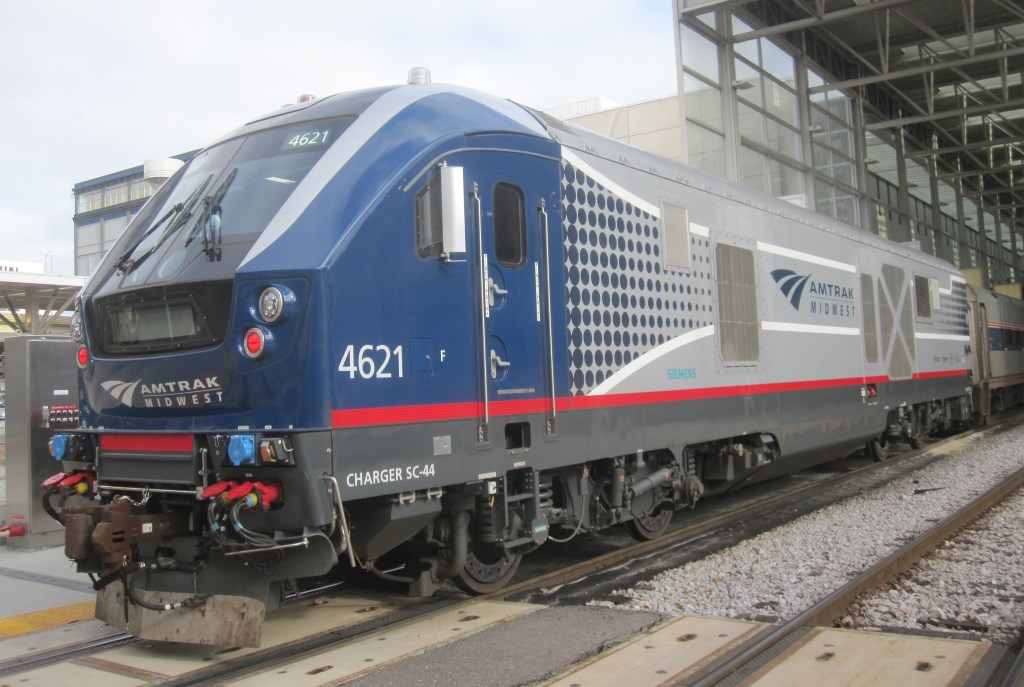
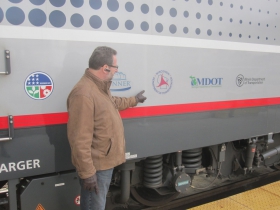
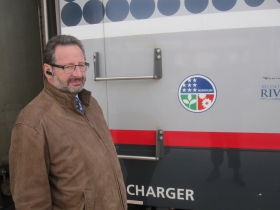
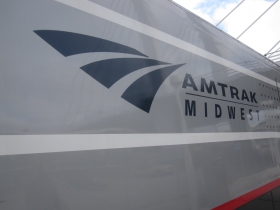
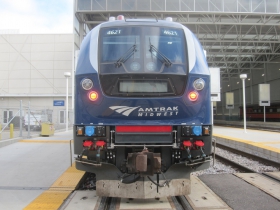
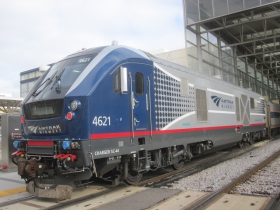
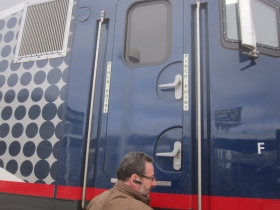


















The locomotives are capable of 125mph operation, but the maximum speed that they will be operated at in the Midwest is 110mph. And the travel time on the Chicago-St. Louis trains has not yet been adjusted downward from 5:30.
Indeed, although geared to run at 125 mph, the new Charger locomotives are restricted to only 79 mph on this Hiawatha route.
Considering how the CNW “400s” operated at 90 mph on its own route between Chicago-Milwaukee thru the North Shore suburbs, including the crossing of many grade crossings, exactly what is the plan for Illinois, Wisconsin, and Amtrak to work with Canadian Pacific to improve the rail infrastructure of the “Hiawatha” to allow for faster schedules?
In respect to the growth of the Chicago and Milwaukee region into a megalopolis, where is the planning to enhance this regional rail corridor by providing intercity passenger service on the ex-CNW route between Chicago-Milwaukee, by serving Evanston, Wilmette, Waukegan, Kenosha, Racine and Mitchell Field? Such a service on the now Union Pacific would be popular for those required to fight heavy auto traffic west from those suburbs to I-94, just to be in a conga line of trucks to Milwaukee?
When Amtrak started in 1971, it’s Chicago-Milwaukee trains could have used either the CNW or the Milwaukee Road tracks, as each had regular passenger service up until then. While the CNW route went through more cities and would presumably attract more passengers, it would have required that Amtrak operate another station in Chicago, since the CNW tracks (UP today) cannot access Chicago Union Station.
To TransitRider: Exactly, quite true. However, much has changed and evolved since 1971. Just as California has successfully adopted the Joint Powers Authority concept to administrate and market intercity trains to inter-connect regions, so must the Midwest adapt to enhance mobility.
In Chicago, Ogilvie Depot is now accessible and across the street from Union Station. Just as with the “Hiawatha,” regional trains along the North Shore would also be bi-directional.
What is important is to acknowledge the parallel markets in this megalopolis and to directly serve them, instead of expecting customers to drive out of their way to the depot.
I like these spspecial benefits but they should offer $5 tickets to bring Chicogoans to the Milwaukee Ballet Nutcracker which is better than the Joffrey.
Where are the INTERIOR pictures ?
@Margaret Atherton – Good point!
J
P 2 and P3 have interior shots including me at the controls.